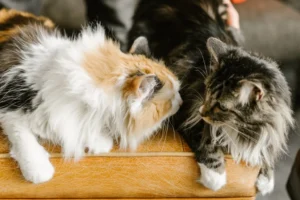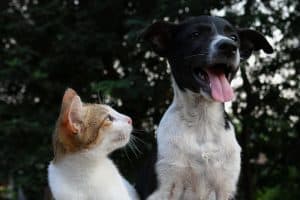Cats are known for their fearless attitude towards other animals, often displaying confidence and curiosity in the face of potential threats. Have you ever wondered why cats seem to lack fear when encountering other creatures? Let’s delve into the reasons behind why cats are not afraid of other animals.
Evolutionary Adaptations
Cats’ behavior towards other animals can be traced back to their evolutionary adaptations as solitary hunters. In the wild, cats primarily hunt alone, relying on stealth and agility to catch their prey. This solitary hunting behavior has made cats self-reliant and less fearful of other animals compared to more social species.
Throughout their evolution, cats have developed specialized traits that have helped them survive as solitary hunters. Their sharp retractable claws, keen eyesight, and powerful jaws make them formidable predators in their natural habitat. This independence and efficiency in hunting have shaped cats’ behavior towards other animals by instilling a sense of confidence and self-assurance when interacting with different species.
Unique Insight: Unlike pack animals that rely on strength in numbers, cats have evolved to be self-sufficient hunters, which has contributed to their fearlessness around other animals.
Superior Senses
Cats possess superior senses of sight, hearing, and smell, which play a significant role in their confidence around other animals. Their acute vision allows them to detect even the slightest movement, making them highly aware of their surroundings. In addition, cats have excellent hearing, which allows them to pick up on sounds that may signal potential dangers or prey nearby.
Another crucial sense that contributes to cats’ fearlessness around other animals is their keen sense of smell. Cats use their olfactory abilities to communicate with other animals, mark their territory, and detect potential threats. This heightened sense of smell gives them valuable information about their environment and helps them navigate interactions with other creatures.
Overall, the combination of superior senses gives cats a heightened awareness of their surroundings and the ability to assess potential threats. These sensory abilities contribute to their confidence and poise when encountering other animals in different situations.
Territorial Instincts
Cats are not afraid of other animals due to their strong territorial instincts. When a cat perceives another animal as an intruder in its territory, it often responds with a fearless attitude to protect its domain. This fearless nature is deeply ingrained in a cat’s behavior, stemming from their ancestors’ need to defend their territory for survival.
Cats mark their territory with scent glands located on their face, paws, and tail, creating a familiar scent that signals ownership. When other animals cross into their territory, cats may exhibit aggression or appear undeterred, displaying a bold front to intimidate intruders. This territorial behavior can make cats seem unafraid of other animals, as they are driven by a strong instinct to defend what they perceive as their own.
In addition, cats are known to be solitary animals, preferring to have control over their environment. This independence contributes to their fearless demeanor towards other animals, as they rely on their territorial instincts to navigate interactions and establish boundaries. Overall, a cat’s territorial nature plays a significant role in their fearlessness towards other animals, as they prioritize defending their territory above all else.
Socialization
Early socialization plays a crucial role in shaping a cat’s interactions with other animals. Kittens that are exposed to various animals, people, and environments at a young age are more likely to develop confidence and adaptability when encountering different creatures later in life. Socialization helps kittens learn appropriate behaviors and communication cues, enabling them to navigate interactions with other animals more effectively.
When kittens are socialized early on, they are less likely to exhibit fear or aggression towards unfamiliar animals. Instead, they are more likely to approach new encounters with curiosity and confidence, leading to a more relaxed and fearless attitude. Socialization helps cats build positive associations with other animals, reducing the likelihood of fearful or aggressive responses during interactions.
It is important for cat owners to prioritize early socialization to help their cats develop strong social skills and confidence around other animals. By exposing kittens to a variety of experiences and individuals during their early development, owners can help them grow into well-adjusted and fearless cats that can interact with other animals in a calm and confident manner.
Additional Insight:
- Providing opportunities for supervised play with other animals, such as dogs or other cats, can help reinforce positive social behaviors and build trust between different species. Gradual introductions and positive reinforcement can help cats feel more comfortable and confident when interacting with other animals.
Size Doesn’t Matter
Cats are not afraid of other animals because their agility and quick reflexes often make them formidable opponents, no matter the size of the opponent. A cat’s ability to swiftly dodge attacks and counter with precision makes them a force to be reckoned with, even against larger animals. Their nimbleness allows them to outmaneuver their adversaries, giving them the upper hand in confrontations. So, whether it’s a bigger dog or a smaller rodent, a cat’s swift movements and sharp instincts can level the playing field in any encounter.
Confidence and Body Language
One reason why cats are not afraid of other animals is due to their confident body language and demeanor. Cats often display a calm and assertive posture, sending a clear message to potential threats that they are not to be messed with. Their subtle yet powerful body language can make other animals think twice before attempting to intimidate or attack them. By exuding confidence through their posture and demeanor, cats establish themselves as formidable opponents, discouraging other animals from seeing them as easy prey.
Additional Insight:
Unique Traits of a Cat’s Body Language
- Tail Position: A cat’s tail position can communicate their mood and intentions. A high-held tail indicates confidence and readiness, while a swishing tail may signal agitation or potential aggression.
- Ears: Cats’ ears are incredibly expressive. Forward-facing ears suggest a curious or alert demeanor, while flattened ears indicate fear or aggression.
- Pupil Dilation: Dilated pupils can indicate excitement, fear, or aggression in cats. Understanding their eye signals can provide insight into their current state of mind.
- Hissing and Growling: When cats hiss or growl, they are clearly communicating their discomfort or aggression. These vocalizations serve as warnings to other animals to back off or face the consequences.
- Arched Back: An arched back paired with raised fur is a clear sign of a cat feeling threatened or aggressive. This defensive posture aims to make the cat appear larger and more intimidating to potential threats.
By recognizing and interpreting these unique characteristics of a cat’s body language, one can better understand why cats are often unafraid of other animals and how they effectively communicate their boundaries and intentions through non-verbal cues.
Curiosity and Play
Cats are known for their insatiable curiosity and playful nature, which can override any sense of fear when encountering other animals. This innate curiosity drives them to investigate and interact with new creatures, rather than retreat in fear. Cats often approach other animals with a sense of intrigue and interest, rather than apprehension. Their playful demeanor also helps them feel more at ease in unfamiliar situations, allowing them to engage with other animals without fear.
Domestication Effects
Living in close proximity to humans may contribute to a cat’s lack of fear towards other animals. Domesticated cats are often exposed to a variety of stimuli from an early age, including interactions with humans and other pets. This exposure helps them become more comfortable and confident in diverse social situations, including encounters with different animals. Additionally, the presence of their human caregivers can provide a sense of security and reassurance, making cats less likely to feel threatened by other animals.
- Socialization: Cats that are well-socialized from a young age tend to be more confident and less fearful around other animals.
- Safe Environment: Providing a safe and secure living space for your cat can help them feel more relaxed and less fearful when encountering other animals.
- Positive Encounters: Encouraging positive interactions between your cat and other animals can help build their confidence and reduce fear.
- Body Language: Pay attention to your cat’s body language when introducing them to other animals. If they appear tense or uncomfortable, give them space and try again later.
- Professional Help: If your cat shows excessive fear or aggression towards other animals, consider seeking guidance from a veterinarian or animal behaviorist.
By understanding the factors that influence a cat’s behavior towards other animals, you can help create a harmonious environment for your feline friend.
Myths and Misconceptions
Contrary to popular belief, cats are not inherently fearless when it comes to other animals. While some cats may appear confident in their interactions with other creatures, many cats actually exhibit signs of fear or caution in unfamiliar situations. Cats may puff up, hiss, or even run away when faced with a threat from another animal.
One common misconception is that cats are always the aggressors in interactions with other animals. In reality, cats are often just as likely to be intimidated or scared by larger or more dominant creatures. It’s essential to remember that every cat is an individual with its own unique personality and behavioral responses.
Fun Facts About Feline Behavior
- Self-Preservation Instinct: Cats may appear unafraid of other animals due to their innate survival instincts. They often rely on their agility, speed, and ability to climb to escape potentially dangerous situations.
- Body Language Signals: Pay attention to your cat’s body language when it encounters other animals. Cats use subtle cues like flattened ears, dilated pupils, and a twitching tail to communicate their feelings of fear or discomfort.
- Socialization Matters: Cats that are well-socialized from a young age are more likely to feel confident and relaxed around other animals. Proper socialization can help reduce fear and anxiety in feline companions.
Remember, while some cats may seem fearless around other animals, it’s essential to respect their boundaries and preferences to ensure their well-being and comfort.
Alex, a passionate animal lover, has experience in training and understanding animal behavior. As a proud pet parent to two dogs and three cats, he founded AnimalReport.net to share insights from animal experts and expand his knowledge of the animal kingdom.









